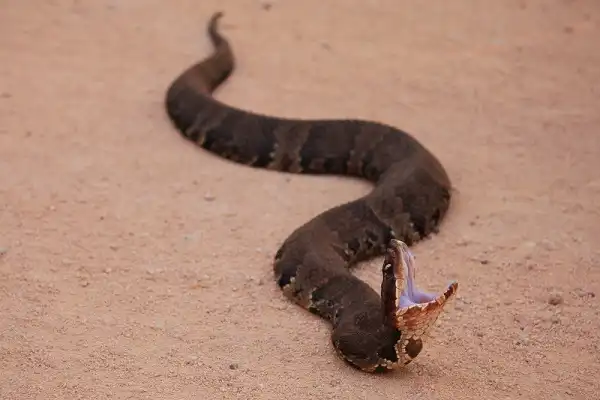If you’re like most people, you probably think of snakes as slimy, slithering creatures that are best avoided. But did you know that there are actually many different types of snakes, and some of them can actually be quite interesting? Take the cottonmouth, for example. Also known as the water moccasin, this snake is native to the southeastern United States and is one of the few venomous snakes in North America. Read on to learn more about this fascinating creature.

Cottonmouth Description
The cottonmouth is a large, powerful snake that can grow up to four feet long. It has an olive-brown or blackish coloring that often features dark bands around its neck and on its back. The underside of the snake is usually light gray or yellow. Cottonmouths also have thick bodies and wide heads, with two distinct pits between the eyes and nostrils that enable them to sense heat from their prey.
Cottonmouth Habitat
The cottonmouth is a semi-aquatic snake, meaning it needs both land and water to survive. It can be found in swamps, marshes, ponds, and slow-moving streams throughout the southeastern United States. The snake does most of its hunting in and around the water, so if you’re out for a walk near a wetland or riverbank, keep an eye out for this curious creature!

Cottonmouth Diet
Cottonmouths are carnivores, meaning they feed on other animals for their meals. They typically eat small fish and frogs, as well as other reptiles such as lizards and snakes. The snakes use their powerful jaws to grab and hold onto their prey before killing and swallowing it whole.
Cottonmouth Size
Adult cottonmouths can grow up to four feet long, with males typically being larger than females. They are considered medium-sized snakes compared to other species, though they can be quite intimidating in person.
Cottonmouth Lifespan
Cottonmouths can live up to 10 years in the wild, but they can live much longer in captivity when given proper care. In fact, some individuals have been documented living for over 20 years in zoos and aquariums! As you can see, the cottonmouth is a fascinating creature that deserves our respect. While it may be venomous, it will only attack if threatened or cornered – so try not to startle one if you come across one on your next outdoor adventure! By understanding more about this snake’s anatomy and habits, we’ll be better prepared to admire them from a safe distance.

Cottonmouth Behavior
Cottonmouths are primarily nocturnal, meaning they like to come out at night when it’s cooler and the prey is easier to find. They’re also ambush predators that prefer to wait motionless in the water until their prey swims by, then strike quickly before the victim can escape. The cottonmouth is very defensive and will often open its mouth wide while hissing loudly as a warning if it feels threatened. This behavior earned it its name because of the white color inside its mouth, which resembles cotton.
Cottonmouth Speed
Cottonmouths are surprisingly fast for their size and can reach speeds of up to 3 miles per hour in the water. They tend to move more slowly on land, but they can still cover a surprising amount of ground when they’re motivated!
Cottonmouth Hunting
The cottonmouth is a skilled hunter and can dive underwater to look for prey. They also hunt on land, using their keen sense of smell and heat-sensing pits to locate potential meals. The snake has an excellent memory and will sometimes remember the locations of its favorite hunting grounds. It’s not uncommon for them to return to the same spot over and over again if they find a steady supply of food there.

Conclusion
The cottonmouth is a fascinating creature that can often be found near wetlands throughout the southeastern United States. While you should definitely take precautions when encountering one of these venomous creatures in the wild, learning more about them is a great way to appreciate their unique beauty and behavior!
Frequently Asked Question


